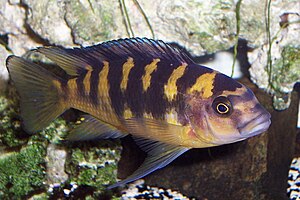Pseudotropheus
| Pseudotropheus | ||||||||||||
|---|---|---|---|---|---|---|---|---|---|---|---|---|

Pseudotropheus crabro |
||||||||||||
| Systematics | ||||||||||||
|
||||||||||||
| Scientific name | ||||||||||||
| Pseudotropheus | ||||||||||||
| Regan , 1922 |
Pseudotropheus (from the Greek "pseud (o)" (ψεύδειν, pseúdein ) = false; "false Tropheus ") is a genus of African cichlids (Cichlidae). In nature they live exclusively in Lake Malawi (which is called Lake Nyassa in Tanzania and Mozambique ) and in the Great Rift Valley . The genus belongs to thembuna boundto the biotope of the rocky coasts . It was originally a species-rich collective genus in which over 50 species were placed. A large number of these species are now assigned to the genera Maylandia , Tropheops and Chindongo . Today 17 species still belong to Pseudotropheus .
features
Pseudotropheus species are 6 to 16.5 centimeters long. There is often a clear gender dimorphism . The genus is still poorly diagnosed and only the type species Pseudotropheus williamsi can be considered typical of the genus. In Pseudotropheus williamsi , when the mouth is closed, the mouth gap is parallel to the line between the tip of the snout and the root of the tail. In terms of body and head shape, size and diet, the individual species differ considerably. Pseudotropheus is closely related to the genus Melanochromis . Like these, all Pseudotropheus species have larger, bilobed, outer jaw teeth, while the inner jaw teeth are small and three-pointed. The pharynx are very small and close together. Compared to Melanochromis , the pharyngeal teeth of Pseudotropheus are more numerous and smaller.
Reproduction
Pseudotropheus species are ovophilic mouthbrooders . The male does not take part in the care of the brood (mother family). Males are faithful to their location and form territories that they defend against male conspecifics and alien cichlids. Females swimming by are attracted. When mating occurs, the eggs are usually deposited individually or in small “portions” (2-3 eggs) in a hollow in the ground or a flat stone and immediately afterwards taken by the female into the mouth. When the male snaps for the yellow egg dummies on the anal fin, the eggs are fertilized. The number of eggs depends on the size and age of the females and is between 20 and 110. Mouth-brooding females leave the male territory and seek shelter in the rocky littoral. The fry hatch after 16 to 26 days. Larger juvenile fish are the same color as the females, the males change color when they reach sexual maturity.
species
There are 17 described and numerous previously undescribed species of the genus first named in 1921 by Charles Tate Regan :
- Pseudotropheus benetos (Bowers & Stauffer, 1997)
- Pseudotropheus brevis (Trewavas, 1935)
- Pseudotropheus crabro (Ribbink & Lewis, 1982)
- Pseudotropheus cyaneorhabdos (Bowers & Stauffer, 1997)
- Pseudotropheus elegans Trewavas, 1935
- Pseudotropheus fuscoides Fryer, 1956
- Pseudotropheus fuscus Trewavas, 1935
- Pseudotropheus galanos Stauffer & Kellogg, 2002
- Pseudotropheus interruptus (Johnson, 1975)
- Pseudotropheus joanjohnsonae (Johnson, 1974)
- Pseudotropheus johannii Eccles, 1973
- Pseudotropheus livingstonii (Boulenger, 1899)
- Pseudotropheus perileucos (Bowers & Stauffer, 1997)
- Pseudotropheus perspicax (Trewavas, 1935)
- Pseudotropheus purpuratus Johnson, 1976
- Pseudotropheus tursiops Burgess & Axelrod, 1975
- Pseudotropheus williamsi (Günther, 1894), type species
literature
- Günther Sterba : The world's freshwater fish. 2nd Edition. Urania, Leipzig / Jena / Berlin 1990, ISBN 3-332-00109-4 .
- Erwin Schraml: Pseudotropheus Regan, 1921. In: Claus Schaefer, Torsten Schröer (Hrsg.): The large lexicon of aquaristics. Eugen Ulmer, Stuttgart 2004, ISBN 3-8001-7497-9 , pp. 828-835.
Web links
- Pseudotropheus on Fishbase.org (English)
Individual evidence
- ^ Charles Tate Regan: The cichlid fishes of Lake Nyassa. In: Proceedings of the Zoological Society of London 1921. Volume 4, No. 36, (January 27) 1922, pp. 675-727 and panels 1-6.



